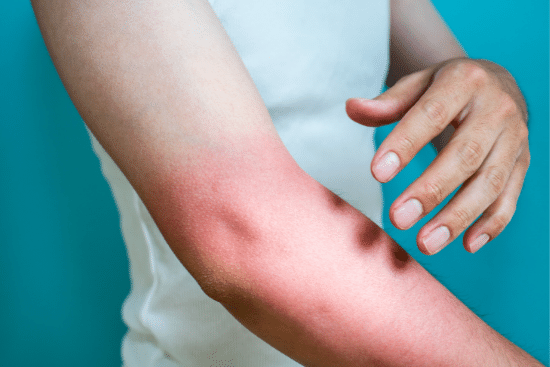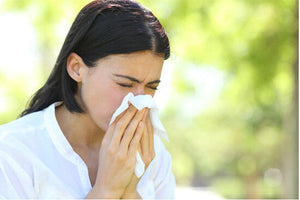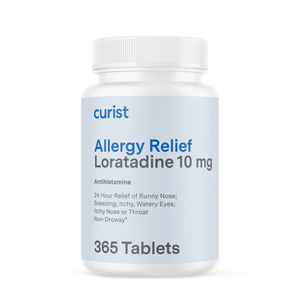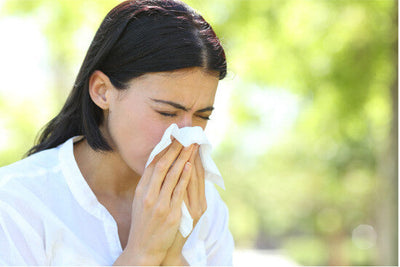By Allison Dinh, The University of Texas at Austin College of Pharmacy
Curist delivers over-the-counter medicines to your door at a fraction of the price of traditional brands. We hope everyone stays safe and healthy during this time.
What are Sun Allergies?
Sun allergies is a broad term that is also known as photosensitivity or a sun rash. It encompasses other conditions such as sun poisoning and solar urticaria. Sun allergies is an immune reaction to sunlight that causes a host of symptoms such as rash, redness, blisters, and hives in serious cases.
Of course, sun allergies are not the only kinds of allergies! Food and pollen are also common allergens. Similarly to sun allergies, food and pollen allergies are the result of the immune system reacting to a foreign substance that it deems as harmful. The difference between these allergies is the allergen or cause of the reaction such as the sun, a specific type of food, or pollen.
What are the Signs of Being Allergic to the Sun?
If you are so to speak, “allergic to the sun” or experience photosensitivity, you may exhibit certain signs. These signs include, but are not limited to redness, scaling, blistering, and itchiness on skin exposed to sunlight.
What is Sun Poisoning vs Sun Allergies?
Sun poisoning is the most common type of sun allergy and is a severe case of sunburns. It is also known by a lengthier name: polymorphic light eruption (PMLE). If your skin is blistering, red, inflamed, or painful to the touch, you may be experiencing sun poisoning. Additional symptoms may include fever, headache, nausea, and dehydration.
What is Solar Urticaria vs Sun Allergies vs Poisoning?
Sun allergy is a general term that also refers to photosensitivity or a sun rash. It includes other conditions like sun poisoning and solar urticaria.
Sun poisoning is more common than solar urticaria. Symptoms of sun poisoning include blistered, red, inflamed, or painful skin. Solar urticaria, in contrast, is characterized by hives and welts in response to sunlight. Symptoms can flare up intermittently or it may be a chronic condition. In contrast to sun poisoning, solar urticaria is a rarer condition and has hives as a distinguishing sign.
What About Itchy Skin After Sun Exposure Without a Rash?
This may still be a sign of potential sun allergies. If this occurs, monitor yourself for other signs and shade yourself from the sun if possible to minimize exposure. To treat the itchiness, using aloe vera or calamine lotion can help. It’s also important to not scratch the area as to not irritate the skin any further.
What are Risk Factors for Sun Allergies?
People can respond differently to the sun based on a variety of factors. Among the top risk factors for sun allergies include:
- Medications: Some antibiotics such as tetracyclines or sulfonamides have high potential for causing photosensitivity. Other medications that can make you more prone to having a sun-induced allergic reaction include NSAIDs such as ibuprofen or amiodarone, a cardiovascular medication.
- Family history: If you have a relative with a sun allergy, you’re more likely to have one as well.
- Skin color: People with lighter or fairer skin are more likely to have a sun allergy than people with darker skin tones. However, this doesn’t mean that those with darker skin are completely safe from getting a sun allergy. It’s important to remain vigilant about sun protection regardless of skin color.
- Having another skin condition: Having another skin condition, such as dermatitis or eczema, makes it more likely for you to have sun allergies. To learn more about these other skin conditions, check out the Curist article on Itchy Skin and Chronic Hives.
How Long Does a Sun Allergy Rash Last?
How long a sun allergy rash lasts varies from person to person depending on how mild or severe the case is. However, some sun rashes may persist for as long as two weeks.
What Does a Sun Allergy Rash Look Like?
A rash caused by the sun typically is red, feels warm or hot to the touch, blistering, or feels rough in texture. And, of course, It appears only on parts of the body that are exposed to the sun, so that make help you distinguish a sun rash from other rashes that may appear elsewhere on your body.
How Can I Prevent Sun Allergies? Can I Get Rid of Sun Allergy?
In terms of getting rid of a sun allergy, there are ways to treat the symptoms, as discussed further below. However, without taking precautions and preventive measures, sun allergy symptoms can return! Ways that you can prevent sun allergies from happening in the first place include:
- Using sunscreen: Apply a generous amount of broad-spectrum sunscreen of at least 30 SPF to your face, neck, arms, legs, and more exposed areas of the body. Don’t forget the ears! Reapply sunscreen every two hours. If you’re swimming or sweating a lot, you will need to reapply more often.
- Wearing protective clothing: Protective clothing includes sunglasses, wide-brimmed hats, and long-sleeved shirts. Ensure that the fabric on your clothes isn’t too thin or else UV rays can easily pass through.
-
Avoiding peak sun hours: The sun’s rays are harshest between 10 AM and 4 PM so if it is possible for you to avoid being out in the sun during those times, that would decrease your risk of developing sun allergies.
How Can I Treat Sun Allergy?
Treatment depends on how severe your case of sun allergies is and what type of sun allergy you have. If you have a mild case, simply staying out of the sun will suffice. However, if you have a more moderate or severe reaction, you can use medications such as oral antihistamines, corticosteroid creams, or calamine lotion.
- Oral antihistamines are medications taken by mouth to prevent allergic reactions from occuring by blocking histamines. Histamines are produced by the body in response to an allergen and cause allergy symptoms. For example, Curist Allergy Relief (levocetirizine) is a third-generation antihistamine designed for 24-hour with minimal drowsiness.
- Corticosteroid creams are topical medications that can be applied to affected skin to reduce inflammation and reduce immune reactions.
-
Calamine is a medication that, when used topically, relieves symptoms of itching and skin irritation caused by sun allergies.
What Is The Best Antihistamine For Sun Allergy?
Taking oral antihistamines can help relieve the rash and other photosensitivity symptoms caused by a sun allergy. The best antihistamine is the one that works well for you and fits your needs. Typically, this includes less drowsy antihistamines such as levocetirizine, loratadine, fexofenadine, and cetirizine. These antihistamines do not cross the blood-brain barrier, which is a collection of cells that acts as a gatekeeper to determine what substances can pass through into the brain. As a result, they are less likely to cause drowsiness. To learn more about antihistamines to treat allergies, check out Curist's Antihistamine FAQ.
Antihistamines like Curist Allergy Relief (levocetirizine) are an effective option for treating sun allergy symptoms.












